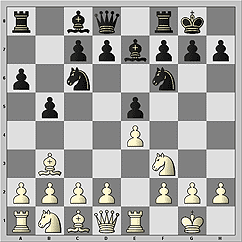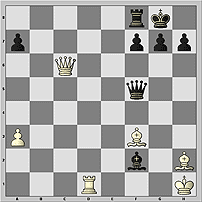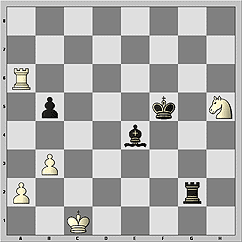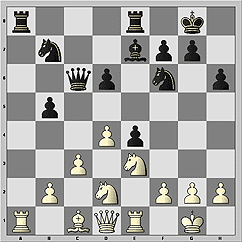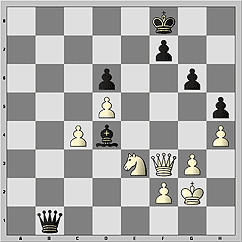 | Последние турниры |
Чемпионат России
СуперФинал

02.12.2006
Суперфинал чемпионата России проходит в Москве, в ЦДШ им. М.М.Ботвинника со 2 по 15 декабря при 12 участниках по круговой системе.
Крамник - Fritz

25.11.2006
С 25 ноября по 5 декабря в Бонне чемпион мира Владимир Крамник сыграет матч из 6 партий с программой Deep Fritz. В случае победы Крамник получит 1 миллион долларов, тем самым удвоив свой стартовый гонорар ($500000).
Мемориал Таля

5.11.2006
В Москве с 5 по 19 ноября проходил Мемориал Таля, в программе которого супертурнир 20-й категории и выдающийся по составу блицтурнир. Призовой фонд каждого состязания - 100.000 долларов.
Топалов - Крамник

23.09.2006
После того как "основное время" не выявило победителя (счет 6:6), 13 октября соперники сыграли 4 дополнительных поединка с укороченным контролем времени.
Томск. Высшая лига

2.09.2006
Со 2 по 11 сентября Томск принимает Высшую лигу чемпионата России 2006 года. В турнире участвуют 58 шахматистов - как получившие персональные приглашения, так и победившие в отборочных состязаниях.
Майнц

17.08.2006
В последние годы фестиваль в Майнце вслед за "Амбер-турниром" стал центром легких шахматных жанров. Наряду с массовыми ристалищами традиционно проходят чемпионские дуэли.
Россия - Китай

10.08.2006
С 10 по 20 августа в Китае проходит товарищеский матч сборных России и Китая. В нынешнем поединке как мужчины, так и женщины соревнуются на пяти досках по шевенингенской системе в два круга.
Все материалы
ChessPro

|
|

|
|
 |
By grandmaster
Sergey SHIPOV |
Look from the screen |
Drop your back-sit driver criticism. It is very easy to urge chess players to fight for victory to the very end in any position looking at the monitor, drinking tea and patting your cat. I am sure that the participants of the World Championship are doing their best. After all the stakes are too high; everyone wants to win. Given the long distance with just a few days off and extensive time control it is very important for GMs to evenly distribute the energy along the tournament.
I see many critics stride around the room, rend the air and lament over the leaders’ draw. They will quickly get back to their couches to have a rest from chess and their own emotions. As for the GMs, they have to prepare for next games, play and fight.
My greatest impression of the recent Olympics 2004 in Athens is the 50km foot-race. The Pole Robert Korzhenevsky and the Russian Denis Nizhegorodov were walking head to head for quite a while but Robert speeded up at the second stage of the distance. Denis stubbornly held out, but finally had to slow down and let the great footman to increase the distance. The race was decided. Indeed the Pole finished first and won the gold medal. As for the Russian, he nearly lost everything. Walking under the scorching sun, with about one kilometer to go, he virtually stopped then staggered, and zigzagged slowly advancing in sinusoid curve. Usually referees are very strict about the racers not switching from walking to running, but this time they watched Nizhegorodov not to fall. I think if the Russian had fallen, he would not have got up. The guy plucked up his spirit, made it to the silver medal, but had to spend several days in hospital. He could not recall what happened at the second stage of the distance! That is what I call squeezing out 101 percent, doing more than one can.
Let’s face it. Topalov is better now. He is the best of all active players. Svidler never could boast of his stamina. It is really hard to compete with the Bulgarian “energizer”. Don’t forget that the tournament is not over yet. Svidler is in for the games with Polgar with black and vs. Anand on the white side! I am sure the Russian GM will show his worth. He has to reach the finish and remain on his feet!
Svidler failed offer to impose a real fight on the leader after his tough seven-hour game with Morozevich. Peter has a classical chess education; bluffing is not his style. Do you remember his game with Kasimdzhanov in the fist part of the event? That was the case. Let me mix different proverbs and word it: What is good for Morozevich bad for Svidler! That is why the GM from St-Petersburg played the game with Topalov in a solid manner, trying to equalize first. When the leader started trading pieces it was just impossible to change the course of the battle. I dare say that it was up to Veselin. If he had run risks pressing for win, Peter would have had his chances.
As for Topalov’s decision, it is not worth discussing. Having his coveted goal in sight he advances with inexorability of a heavy tank. Among other events I should bring your attention to Anand’s acceleration. A couple of rounds ago many experts (including your truly) thought that Vishy had thrown in the towel. We were all wrong! This experienced fighter is playing to the best of his abilities. He tries to score the maximum FINAL result not just an to stage an impressive performance at a particular stage of the tournament.
Now we may muse over the hypothetical situation with White’s playing 16.Qd3! in the Anand – Topalov game and winning the encounter. First, it is not chiseled in stone that White would have won this game. Based on the latest information, Topalov was familiar with this position, whereas Vishy saw it for the first time. Second, what would have been Vishy condition after this hypothetical victory? Would he have been able to play as well as he actually did, tomorrow and one day after tomorrow? There are many questions but unfortunately no answers. OK, enough words. For some reason I am in talkative mood today. Let’s check out the games.
Even those who followed the game in the Internet felt the tremendous tension in the air. Both players put their best in every move. However, the chessic content of the encounter is equal to zero. The opponents made two new moves in the equal theoretical position and drew the game.
Ruy Lopez C88
Veselin TOPALOV (BUL) – Peter SVIDLER (RUS)
1.e4 e5 2.Nf3 Nc6 3.Bb5 a6 4.Ba4 Nf6 5.0–0 Be7 6.Re1 b5 7.Bb3 0–0.
8.h3! The game Anand – Svidler convincingly proved that the Marshall attack was still alive. It also demonstrated that Svidler was one of the best experts in this line.
8...Bb7 9.d3 d6 10.a3 Qd7 11.Nc3 Nd8 12.d4 exd4 13.Nxd4 Re8 14.Nf5.
14...Ne6! The retreat of the black bishop was refuted in the game Anand – Shirov (Mainz, 2004): 14...Bf8? 15.Bg5 Bxe4 16.Nxe4 Rxe4 17.Rxe4 Qxf5 (17...Nxe4 18.Qg4! Nxg5 19.Nh6+) 18.Bxf6 Qxe4 19.Bd5 Qf4 20.Bxa8 Qxf6 21.c3 c6 22.Qd4 Qe6 23.Qb6 Qc8 24.Re1! and White won soon.
15.Nxe7+ Rxe7 16.f3 Rd8 17.Bxe6 fxe6 18.e5 dxe5 19.Qxd7 Rdxd7 20.Rxe5.
20...Rd6. The sequence 20...h6 21.Be3 Nd5 22.Nxd5 Rxd5 23.Rxd5 Bxd5 24.a4 Kf7 25.axb5 axb5 26.Ra7 c6 27.Rxe7+ leads to the same result. The game Anand – Shirov (Mainz, 2004) was drawn at this point.
21.Bf4. Black can play 21...Nd5, forcing further exchanges. The opposite-colored bishops leave no chance for the decisive outcome. Draw.
The old rivals produced the only decisive game of the round. The opponents made an important contribution to the opening theory, pleased the connoisseurs and entertained the spectators. Everyone enjoyed it except Leko…
Petroff Defense C42
Peter LEKO (HUN) – Vishvwanathan ANAND (IND)
1.e4 e5 2.Nf3 Nf6. When and who brought into fashion all these talks about the Petroff Defense being a boring drawish opening? This statement sounds old and amateurish. This opening offers many lines with complicated play and immense room for creativity! Work on, play and enjoy it!
3.Nxe5 d6 4.Nf3 Nxe4 5.d4 d5 6.Bd3 Nc6 7.0–0 Be7 8.c4 Nb4 9.Be2 0–0 10.a3 Nc6 11.cxd5 Qxd5 12.Nc3 Nxc3 13.bxc3 Bf5 14.Re1 Rfe8 15.Bf4 Rac8 16.h3.
16...Be4! Bologan’s idea. What is behind this move? The point is that White has a promising plan – to retreat the knight to d2, transfer the bishop to f3 putting pressure on Black’s queenside. Then White’s knight advances to e4 or c4. Black’s plan is aimed at foiling this regrouping by putting pressure on the g2-pawn. After the promulgation of this novelty analysts asked themselves whether 16…Be4 really prevent 17.Nd2. This problem has been analyzed in home laboratories for a whole year. Finally, the results were disclosed.
17.Nd2!? In the games Leko – Bologan (Dortmund, bltiz 2004) and Leko – Kramnik (Bressago, 2004) the Hungarian GM played an unassuming 17.Be3, but to no effect. To make it worse, he fell into real trouble at the start of the match in Switzerland: 17...Na5! 18.c4 Nxc4 19.Bxc4 Qxc4 20.Nd2 Qd5 21.Nxe4 Qxe4 22.Bg5 Qxe1+ 23.Qxe1 Bxg5 24.Qa5 Bf6 25.Qxa7 c5! – Black got excellent compensation for the queen. Peter did not feel the danger and lost. The tournament practice showed that 17.Bd3 was not dangerous for Black either. For example 17...Bxf3 18.Qxf3 Qxf3 19.gxf3 Bd6 20.Rxe8+ Rxe8 21.Be3 Na5 22.Rb1 Rc8 23.Bf5 Rb8 24.Bd3 Rc8 25.Bf5 1/2 Akopian – Bacrot (San-Vincent, 2005).
17...Bxg2 18.Bg4 (after 18.c4 Qf5! 19.Bg4 Qxf4 20.Bxc8 Rxc8 21.Kxg2 Qxd4 Black has more than sufficient compensation for the exchange.) 18...Bh1! The bishop gets from under fire with tempi, which nothing more than the checkmate threat! Alexander Huzman in his comments for ChessBase mentioned this move as deserving attention. He focused on the continuation 18...f5 gave the following lines: 19.Be2 b5 20.c4 (20.a4 a6 21.axb5 axb5 22.c4 Qxd4 23.Be3 Qd6 24.Kxg2 f4 25.Ne4 Qxd1 26.Rexd1 fxe3 27.cxb5 Nb4=) 20...Qxd4 21.Be3 Qd6 22.Kxg2 f4 23.Ne4 Qg6+ 24.Ng3 Rcd8 25.Qb3 Qf7 26.Bh5 g6 27.Bf3 bxc4 28.Qb5 Nb8 29.Bxa7 fxg3 30.fxg3 Rd2+ 31.Re2 c6 32.Rxd2 cxb5 33.Bd5 Nc6 34.Bg1 Rb8=
Appearently Vishy and Peter took some bias of this analysis by the Israeli GM and concluded that White was better in this line.
19.f3 (the black bishop is trapped) 19...Bh4!? Here comes the improvement (I doubt that it is an impairment) of Huzman’s analysis who recommended 19...f5 20.Bh5 g6 21.Kh1 gxh5 22.Qb1 “with compensation for White”.
20.Rf1!? Cunningly played. After 20.Rxe8+ I hoped to give a short, plausible line. However I bogged down and now you can see the result: 20...Rxe8 21.Qb3 (21.Kxh1? Re1+ 22.Qxe1 Bxe1 23.Rxe1 f5) 21...Bxf3 22.Bxf3 Qf5 23.Qxb7! (23.Bxc6 Qxf4 24.Bxe8 Qg3+ 25.Kh1 Qxh3+ 26.Kg1 Qg3+ 27.Kh1=) 23...Nxd4! 24.Bxc7 Qc5! 25.Kh1 Qxc3 26.Rd1 Be1! 27.Bd5! Qxh3+ 28.Bh2 Qf5 29.Nf3 (29.Be4!?) 29...Nxf3 30.Qc6 Rf8 31.Bxf3 Bf2
I reached some sort of comprehensive position only here. White has some (probably sizable) advantage. Consequently, the exchange on e8 (after somewhat artificial retreat of the white rook) deserves a closer look and maybe even the practical test.
20...f5! 21.Bh5 g6 (the white bishop is trapped too) 22.Kxh1 gxh5 23.Rg1+. That was Leko’s idea. He believes that the g-file is more important than the e-file. I think both black and white kings share this opinion.
23...Kh8 (here the white queen transfer to the center on d3 via b1 with tempi) 24.Qf1.
The opponents sank into reflections. Up to this moment they confidently made the moves on the board. All we have left is to admire the workload both GMs did in their preparation. Remember that it is just of side variations of the optional opening. How many lines they have to work on? Just think about it! All these lines have to be stored in memory; the opponents like openings surprises!
24...Bf6. Black is consolidating his position. Naturally, his extra pawn at the edge of the board is of no importance. However, after spring comes the summer and then fall. Drawing analogy with chess, one should remember about endgame when playing the opening.
25.Rb1. Probably that is the first inaccuracy. The white rook’s activity on the queenside does not bother Black. Actually White has no advantage in any case. White could have dislodge the black queen from her excellent position only with 25.Qc4!?, but apparently the queen exchange was in conflict with Leko’s aggressive intentions.
25...Ne7! (good maneuver; the knight is heading to g6 to patch up Black’s shattered kingside) 26.Bg5. On 26.Qc4 Black has a strong rejoinder 26...c5! After 26.Be3 (with the idea of c3-c4) White should reckon with the same 26...c5!?
26...Bxg5 27.Rxg5 Rg8! (Vishy joins the ranks of the g-file’s fans) 28.Rxg8+ Rxg8 29.Qe2 Ng6 (the black pieces are gradually flowing closer the kings) 30.Rb5. Whereas White’s pieces are trying to go through the center.
30...Qc6! It became clear at this point that White’s strategy failed. I mean strategy, not just some separate move.
31.Rxf5. Looking for practical chances Peter is trying to complicate the position. On 31.Rc5 Black reacts with 31...Re8! It turned out that in many lines White’s first rank was very weak. This weakness is caused by the trip of White’s rook.
31...Qxc3 32.Rd5 Qxa3! (extra pawns will serve Black a good stead on a rainy day!) 33.Kh2. Revealing move. Being two pawns down White has to defend.
33...Qf8! The final portion of the game is Black’s confident conversion of his advantage in White’s time trouble.
34.Qe6 Qf4+ 35.Kh1 Rf8 (even better was 35...c6! 36.Rxh5 Qxd4) 36.Qe2 h4 37.Rd7 Rf7 38.Rd8+ Kg7 39.Ne4 Qxf3+ 40.Qxf3 Rxf3. Three extra pawns is way too much. Peter’s disappointment is the only explanation of Black’s long and useless resistance.
41.Nc5 b6 42.Ne6+ Kf6 43.Nxc7 Rxh3+ 44.Kg1 Rd3 45.Nb5 Kg5! 46.Nxa7 h3 (this very doubled pawn that Black won in the opening brings him the victory) 47.Nc6 Kg4 48.Ra8 Kg3 49.Ra1 h2+ 50.Kh1 Nf4 51.Ne5 Re3 52.Rd1 Kh3 53.Nf7.
53...Rg3! The black knight heads to e2, the rook goes g1 and the hero-pawn is promoted with checkmate. Repair your sleigh in July, provision yourself with extra pawns in opening!
If someone asked me before the event what game would not be drawn for sure, I would not hesitate to point out this encounter. Sasha is known for his fighting temper, whereas Judit is not someone to be invited twice to dart into a scuffle. It is beyond belief that these two chess gladiators drew in the round when usually careful and solid Leko lost with White! As for the game itself, it was quite interesting. The fighters swept off most of the pieces; they did not have enough resources to continue the battle.
Sicilian Defense B90
Alexander MOROZEVICH (RUS) – Judit POLGAR (HUN)
1.Nc3. This first move brought Alexander luck at the blitz tournament organized by the newspaper “Vechernyaya Moskva” (actually he ironically called this continuation his secret weapon for Argentina). In the real serious game it came down to a simple transposition.
1...c5 2.Nf3 Nf6 3.e4 d6 4.d4 cxd4 5.Nxd4 a6 6.Be3 Ng4. Agaign we see the Najdorf variation with the knight’s lunge to g4. I don’t know how most of the participants called this system, but I think it should be something with the worlds Argentina, San Luis, Topalov, etc. On the other hand it sound like oxymoron. After all Najdorf was from Argentina! There problems is that after 5…a6 there are too many different systems and each of them deserves a name: Najdorf 1, Najdorf 2, etc.
7.Bg5 h6 8.Bh4 g5 9.Bg3 Bg7 10.Be2 (Prior to this game the participants tested 10.h3 Ne5 and here either 11.Nf5 or 11.f3) 10...h5 11.h4 gxh4 12.Rxh4 Nc6 13.Nb3 Be6 14.Qd2.
14...Rc8. After 14...Qb6 15.Nd5 Bxd5 16.exd5 Nce5 17.c3 Ng6 18.Rh3 h4 19.Bxg4 hxg3 20.Rxh8+ Bxh8 21.Qe3 gxf2+ 22.Kxf2 Qxe3+ 23.Kxe3 Ne5 Black transposed in a better endgame and gradually won (Topalov – Kasparov, rapid chess,Geneva 1996). I think Topalov-2005 would be able to improve White’s play.
15.0–0–0 Qb6. Interesting novelty. Previously Black tried 15...Bf6 16.Rhh1 h4 17.Nd5 Bxd5 18.exd5 Nce5 19.Bxe5 Nxe5 20.Qb4 Qc7 21.c3 Rg8 22.Rhg1 Kf8 23.Kb1 Qd7 24.Qf4 Rg5 25.Nd4 and White emerged clearly better (Movsesian – Kalod, Olomouc 1997). Black’s king is very vulnerable whereas the queens are still on the board.
16.f3. Only diligent home preparation can one venture upon a hurricane-like 16.Kb1!? Nxf2 17.Rf1 Ng4 18.Nd5 Bxd5 (18...Qa7 19.Qg5!) 19.Qxd5 (надо смотреть и 19.exd5 Nce5 20.Bxe5 Nxe5 21.Bxh5) 19...Nf6 20.Qf5 Qc7 21.e5!? (it is just my fantasy) 21...dxe5 22.Nc5 and, as my old friend Nikolai Vlassov likes to say, then somehow… Actually White has a dangerous initiative in this line.
16...Qe3! Insidious reply. Judit managed to repeat Garry’s feat. By trading queens she take out the opponent’s sting. Black’s king has nothing to worry about.
17.Bf4. Naturally, Black’s dark-squared bishop should not be left without the opponent: 17.fxg4 Qxg3 18.Rxh5, bearing in mind, that it can immediately leave the board disrupting White’s pawn structure – 18...Bxc3!? 19.bxc3 Rg8 и т.д.
17...Qxd2+ 18.Rxd2 Nge5 Black demonstrates her aggressive intentions. I think from the standpoint of equalizing sufficient was 18...Bxc3 19.bxc3 Nge5 20.Be3 Ng6 21.Rh1 Nce5. Black pieces occupy the c4-square.
19.Be3 Bf6 (Black can’t take control over the f4-square: 19...Ng6 20.Rh1 Be5 – 20...h4 21.Nd5 – 21.Nd5!) 20.Rh1 Nc4 21.Bxc4 Bxc4.
22.Na4! Sometimes the c3-knight gets to d5 in a roundabout way with several jumps in the Sicilian Defense. Check out how skillfully Morozevich carried out this strategic maneuver.
22...b5 (that is the best way to protect the c4-bishop) 23.Nb6 Rb8 24.Kb1 (probably at this point Black should have urgently activate her knight - 24...Ne5!?) 24...h4 25.f4! I was under impression here that Sasha had intercepted the initiative and would gradually press his opponent down. The first assumption was correct, the send proved wrong. 25...Rb7 26.Nc1!? Maybe it is not the best but for sure the most consistent continuation. White’s task is to drive Black’s light-squared bishop out from the center.
26...Rg8 27.Rh3 (27.b3 Rg3!) 27...Rg4 (that is the flip side of f3-f4) 28.b3 Be6 29.Ne2 (interesting pawn sacrifice) 29...Rxg2 30.f5. One of the key moment in the game. What to do? This questions sounds so simple…
30...Bd7 Apparently Judit did not bother mulling over this simple question. Am I under attack? OK I am retreating! First, Black had an interesting exchange sacrifice at her disposal, namely – 30...Rxb6 31.Bxb6 Bd7, and then rook goes to g4. Another option is the piece sacrifice – 30...Ne5!? 31.fxe6 fxe6. Black has two pawns for the prodigal knight. Besides, this knight will end up badly anyway. 31.Nd5 (the knight reached the peak! ) 31...Ne5 Judit lures Alexander into trading on f6. The d5-knight is too strong! After 31...Be5 32.Rxh4 White is slightly better.
32.Nxf6+ exf6 33.Nc3 Rg3.
34.Rxg3 (in case of 34.Rxh4 Bc6 – 34...Rxe3? 35.Rh8+ Ke7 36.Nd5# – 35.Bd4 Ke7 Black obtains a very solid position) 34...hxg3 35.Nd5 Bc6! 36.Nxf6+ Ke7 37.Nh5 f6. In the opponent’s time trouble Polgar missed the line 37...Nf3! 38.Re2 g2 39.Rxg2 Bxe4 with an immediate equalizing. 38.Nxg3 Rb8 39.Rh2 Rg8 40.Rh7+ Nf7 The activity of the black pieces offset White’s extra pawn.
41.Bf4 Rg4 42.Nh5 Bxe4 43.Bxd6+ Kxd6 44.Rxf7 Rg2 45.Rxf6+ Ke5 46.Re6+ Kxf5 47.Rxa6 Bxc2+ 48.Kc1 Be4. My previous words can be applied here.
49.Ra5 Bd3 50.a4 Rc2+ 51.Kd1 Ra2 52.Kc1 Rc2+ 53.Kd1 Ra2 54.Kc1 Rc2+.
Draw.
We have to give credits not only to the leaders, but to the outsiders of the WC. They keep fighting and try to change their ill fate. In the following game Rustam and Michael managed to transform a dull maneuvering position into a bloody battle-field. However, the outcome was the same – neither opponent scored the victory...
Ruy Lopez C88
Rustam KASIMDZHANOV (UZB) – Michael ADAMS (ENG)
1.e4 e5 2.Nf3 Nc6 3.Bb5 a6 4.Ba4 Nf6 5.0–0 Be7 6.Re1 b5 7.Bb3 0–0 8.a4 Bb7 9.d3 d6 10.Nbd2 Qd7 11.c3 Rfe8 12.Nf1 h6 13.Ne3.
13...Na5. Black’s knight starts a risky maneuver. Black can equalize with a standard 13...Nd8, for example: 14.Nf5 Bf8 15.N3h4 Kh8 16.axb5 axb5 17.Rxa8 Bxa8 18.Qf3 Ng8 19.Ne3 Ne6 20.Nhf5 Nc5 21.Bc2 g6 22.Nh4 Bg7 23.Nd5 Rf8 24.Be3 c6 25.Nb4 Na4 26.Bxa4 bxa4 27.d4 Qe7 (Zhang Zhong – Hebden, Hastings 2002).
14.Bd5! Bxd5 15.exd5 Nb7 (the black knight strives for freedom) 16.d4 e4 17.Nd2 c6 18.dxc6 Qxc6 19.axb5 axb5.
20.d5! (White plays in an aggressive style; he lets the knight out but cuts off e4 pawn from Black’s troops) 20...Qc7. One can’t calculate all the lines after the pawn capture. The feeling of White’s initiative being too strong comes immediately, so it’s pretty hard to venture upon such a decision. The following line seems possible: 20...Nxd5 21.Rxa8 Rxa8 22.Nf5! (inferior is 22.Nxe4 Nxe3 23.Rxe3 Ra1) 22...e3! 23.fxe3! Re8 (or 23...Bf8 24.Qg4 Kh8 25.Nd4 Nf6 26.Qe2 followed by the capture on b5) 24.Qg4 Bg5 25.Ne4 Qc4 26.Nd4! Nf6 27.Nxf6+ Bxf6 28.Qd7, and White is a pawn up.
21.Rxa8 Rxa8 22.Qe2. Rustam wants to win a flank pawn by all means. Michael readily cooperates. 22.Ng4!, deploying the white pieces for an attack, looks promising.
22...Nc5! 23.Qxb5 Nd3 24.Rd1 Ra5 25.Qc4.
25...Qb7?! This pawn sacrifice did not pay off. It looks like Black should have opted 25...Qxc4 26.Ndxc4 Ra1 27.Bd2 Rxd1+ 28.Nxd1 Nxd5 and accurately played for a draw with equal material.
26.Nxe4 Nxc1 27.Rxc1 Qxb2 28.Rf1?! Both opponents didn’t notice that after 28.Qc8+! Kh7 29.Rf1 Black has no way to simplify the position as 29...Nxe4? is refuted by 30.Qf5+ Kg8 31.Nc4! and Black loses an exchange.
28...Nxe4 29.Qxe4 Ra7 30.c4 g6. Now Black is just in time to mount defense.
31.g3 Kg7 32.Rb1 Ra1 33.Rxa1 Qxa1+ 34.Kg2 Bf6 35.Qd3 Qb2 36.Nc2 h5 37.h4 Kf8 38.Qe4 Qb1 39.Qe2 Qb2 40.Qd3 Qb1 (White’s main problem is that his knight can’t find a good place) 41.Qf3 Be5 42.Ne3 Bd4. This attempt of breakthrough brings about inevitable drawing exchanges.
43.g4 hxg4 44.Nxg4 Qc1 45.Qd3 Ba7 46.Ne3 Bxe3! 47.fxe3 Qe1 48.Qd4.
The opponents can’t avoid perpetual. Draw.
Standing after twelfth round: 1. Topalov – 9; 2–3. Svidler and Anand – 7,5; 4. Morozevich – 6; 5–6. Leko and Kasimdzhanov – 5; 7. Adams – 4,5; 8. Pogar – 3,5.
|
|

